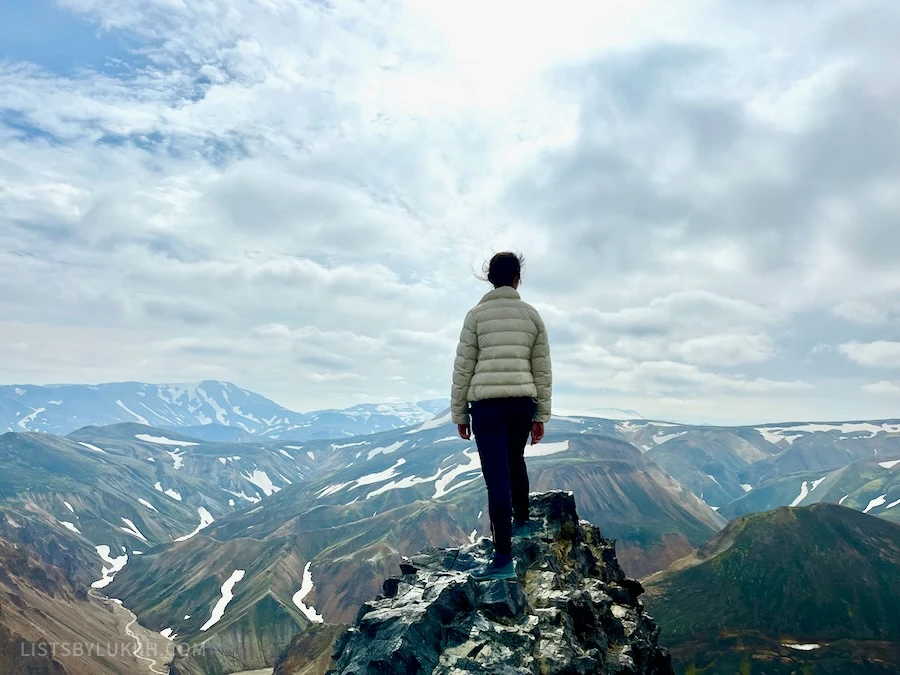Iceland, known as the “Land of Fire and Ice,” is home to epic natural landscapes, hot springs, and wildlife.
One week is enough time to travel through the island’s South Coast, a large portion of the best part of the Ring Road that wraps around the island.
This Iceland road trip itinerary visits over 20 top attractions and hidden gems, including epic hikes, waterfalls, and hot springs. It’s ideal for those who want to see the highlights while being active and adventurous. This post covers:
- 🗓️ 1-week optimized itinerary
- ⭐️ 20+ top attractions & epic hikes
- 📍 Iceland map with key places
- 🛞 Daily driving distance & time
- 🏕️ Where to stay
- ✏️ Iceland trip planner
🇮🇸 Planning a Trip to Iceland: 11 Practical Things To Know
- Itinerary Route
- About This Itinerary
- Essential Tips
- Iceland Map
- 7-Day Itinerary
- Day 1: Blue Lagoon & Volcano
- Day 2: Golden Circle & Hot Spring
- Day 3: Landmannalaugar Hike
- Day 4: Waterfalls & Canyon
- Day 5: Glacier Hike & Lagoons
- Day 6: Svartifoss, Beach & Secret Lagoon
- Day 7: Glymur Hike & Reykjavík
- With More Time
Lists By Lukiih is readers-supported. When you buy with my affiliate link, I may earn a small commission. Thanks!
Iceland Itinerary Route
This itinerary takes you through the best places on the South Coast of Iceland, with optional hidden gems sprinkled in.
About This Iceland Itinerary
This Iceland itinerary efficiently sequences attractions and activities the island country is famous for. It gives you the opportunity to:
- Hike Iceland’s Highlands, an uninhabited mountainous region
- Relax in three distinct hot springs
- See over five famous waterfalls
- Go on a unique glacier hike and two other hikes
- See the stunning glacier lagoons and black-sand beaches
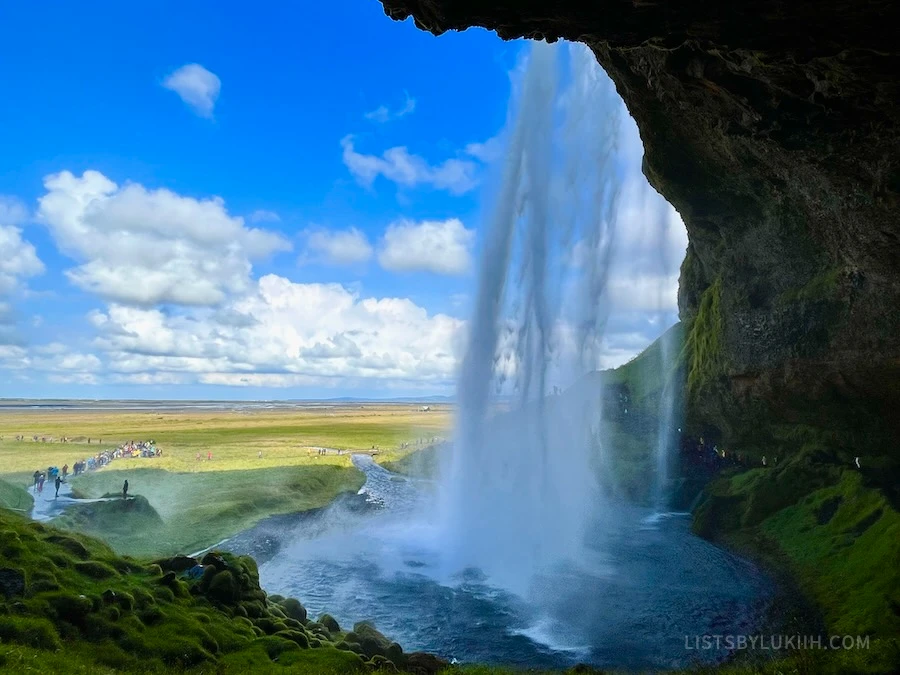
6 Essential Tips for Visiting Iceland
Before getting into the itinerary, here are practical tips to know when traveling to Iceland.
☀️ 1. The best time to go on a road trip in Iceland is in the summer.
Iceland’s weather is notoriously known to be volatile year-round, but it’s significantly warmer during the peak summer season (June to August) when the weather averages 45 °F to 60 °F.
During the summer, the sun rises early (between 3 am and 6 am) and sets late (between 9 pm and 12 am). The long days give you more time to explore.
The warmer weather and longer days make Iceland a great place to go on a road trip in the summer months.
See what it’s like to visit Iceland in the summer.
That said, my friends had a great trip doing this Iceland itinerary during the winter season:
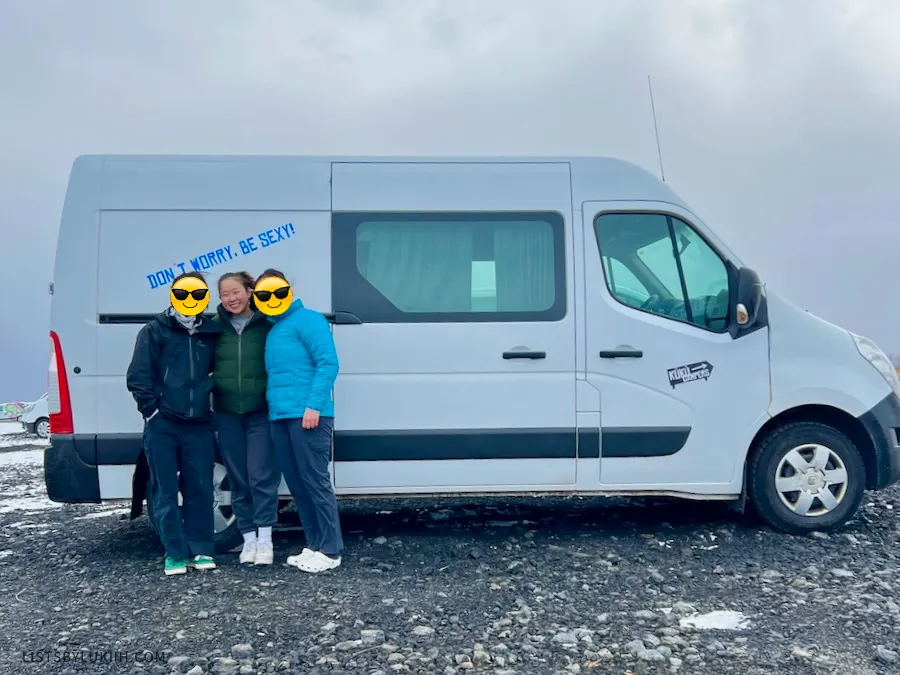
🚙 2. Skip the full Ring Road if you only have a week.
Many visitors aspire to travel the entire Ring Road, the main road that wraps around the island, during their Iceland trip.
I recommend doing the full Ring Road only if you have ten or more days. You can do it in eight days, but you’ll feel rushed and have to skip many sites.
At $8 a gallon, gas is also costly in Iceland. A trip around the entire Ring Road can easily add more than $400 to your trip’s budget.
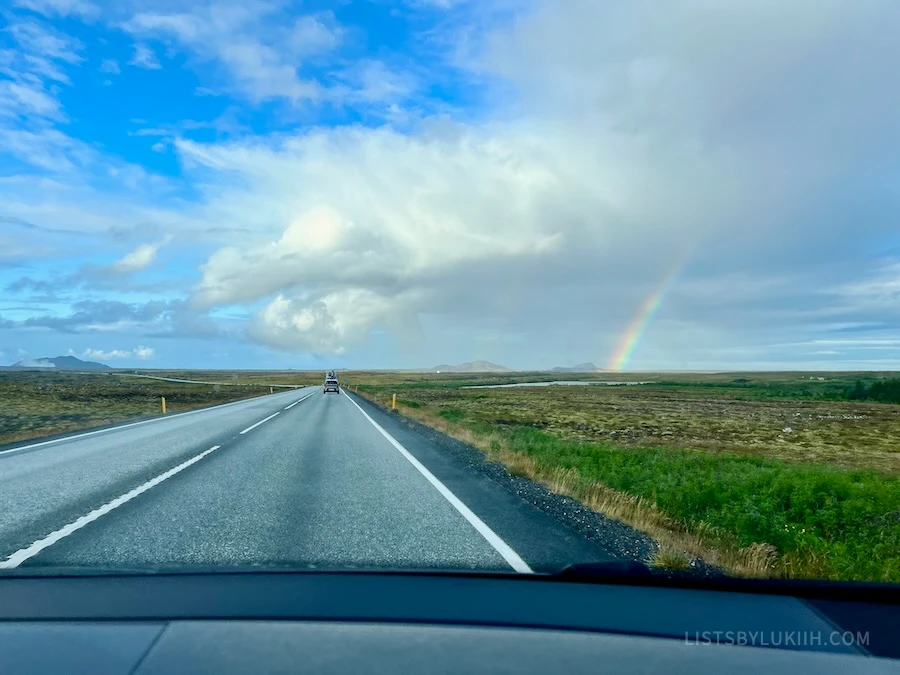
If you have a week, you’ll have an amazing time just exploring the South Coast, as it’s home to numerous stunning attractions.
🚘 3. You likely don’t need a 4WD vehicle.
Overall, Iceland has well-paved streets and good road conditions. However, it also has gravel roads and F-roads, which are mountainous roads typically located in the uninhabited area of the island.
You’re required to have a 4WD rental car if you plan to drive on F-roads.
If you’re not spending significant time in the Highlands (the uninhabited area), you don’t need a more expensive 4WD vehicle. This itinerary visits the Highlands for a day but relies on a bus to get there.
💵 4. Don’t worry about cash and cell signal.
Iceland has an excellent credit card infrastructure, so you’ll rarely need cash.
I share all my travel expenses in this Iceland budget breakdown.
It also has good Wi-Fi at many locations, with a few places that drop to 3G (e.g., between Vík and Skaftafell National Park).
🛞 5. Get to know Iceland’s road rules and driving norms.
Iceland has a few unique road rules and driving norms you should know before taking a road trip there.
For example, the speed limit is relatively low (i.e., 90 kph/56 mph on highways), and headlights must always be on.
Iceland’s Ring Road is typically two-lane, so passing is very common.
Learn about unique Iceland road rules and driving norms.
🚐 6. Consider campervanning around Iceland.
Iceland is an excellent place to campervan because of its safe environment, well-maintained campsites, and straightforward main road.
I’ve never campervanned before and genuinely had a great time doing it in Iceland. I now think it’s the best way to travel around this island country.
See how to have a successful campervan trip in Iceland.

Learn other practical tips when traveling to Iceland.
Iceland Map
This map has all the recommended places in the Iceland travel itinerary below.
7-Day Itinerary for Iceland
The itinerary covers 933 miles with 20 hours of driving and four hours of bus riding over one week.
To help you plan efficiently, I’ve included suggested times for each activity based on my firsthand experience.
The Iceland trip planner below has this itinerary prefilled.
| Day 1 – Blue Lagoon & Volcano Hike or Reykjavík | ||
| 🚙 | Arrive and pickup rental | 6–8 am |
| 🌀 | Relax in the Blue Lagoon | 8–11 am |
| 🌋 | Hike an erupting volcano or visit Reykjavík | 1:30–5 pm |
| Day 2 – Golden Circle & Hot Spring | ||
| ⛰️ | Visit Kerid Crater | 11 am–12 pm |
| 🟡 | Tour the Golden Circle | 1:30–6:30 pm |
| 🔥 | Relax in Hrunalaug Hot Spring | 7:45–9 pm |
| Day 3 – Landmannalaugar Day Hike | ||
| 🚌 | Bus to the Highlands | 9:10–11:20 am |
| 🥾 | Hike Landmannalaugar | 11:30 am–3:30 pm |
| 🚌 | Bus back | 4:30–6:30 pm |
| Day 4 – Waterfalls, Horse Riding & Canyon | ||
| 💧 | Visit Seljalandsfoss and Gljufabrui | 10–11 am |
| 💧 | Visit Skógafoss and Kvernufoss | 11 am–12:30 pm |
| 🐴 | Ride or feed an Icelandic horse | 2:15–3:30 pm |
| 🐍 | See Fjaðrárgljúfur Canyon | 4–5 pm |
| 🪨 | Quick stop at Dverghamrar | 5:30–5:50 pm |
| Day 5 – Glacier Hiker, Lagoons & Diamond Beach | ||
| 🏔️ | Hike Vatnajökull or Múlagljúfur Canyon | 9:20 am–3 pm |
| 💎 | Visit Jökulsárlón Glacier Lagoon & Diamond Beach | 4:45–6:15 pm |
| 🧊 | Quick stop at Fjallsárlón Glacier Lagoon | 6:30–6:45 pm |
| Day 6 – Svartifoss, Black Sand Beach & Secret Lagoon | ||
| 💧 | Hike to Svartifoss | 9:30 am–10:45 am |
| 🐧 | Visit Dyrhólaey Arch to see puffins | 1:15–2 pm |
| 🏖️ | Climb the sea stacks at Reynisfjara Black Sand Beach | 2:15–3 pm |
| 🥾 | Hike part of Waterfall Way | 3:30–5 pm |
| 🌡️ | Relax in Secret Lagoon | 6:30–8:15 pm |
| Day 7 – Glymur Waterfall Hike & Reykjavík | ||
| 🥾 | Hike Glymur Waterfall | 10:30 am–1:15 pm |
| 🦈 | Visit Reykjavík | 2:15–6:30 pm |
All prices mentioned here are in USD 💵 .
Day 1: Blue Lagoon & Volcano Hike or Reykjavík
After landing in Reykjavík and picking up your rental, drive to the iconic first stop.
| Driving Information for Day 1 | |
|---|---|
| 📍 Driving Route Map | See Day 1 Route |
| 📏 Distance Covered | 71 miles |
| ⏰ Drive Time | 1 hr 45 mins |
Stop #1: Blue Lagoon
The Blue Lagoon is a geothermal spa that’s one of the 25 wonders of the world. With its surreal milky-blue water, it’s one of Iceland’s most iconic places. The complex boasts a spa bar, mud mask area, sauna, restaurant, and more.
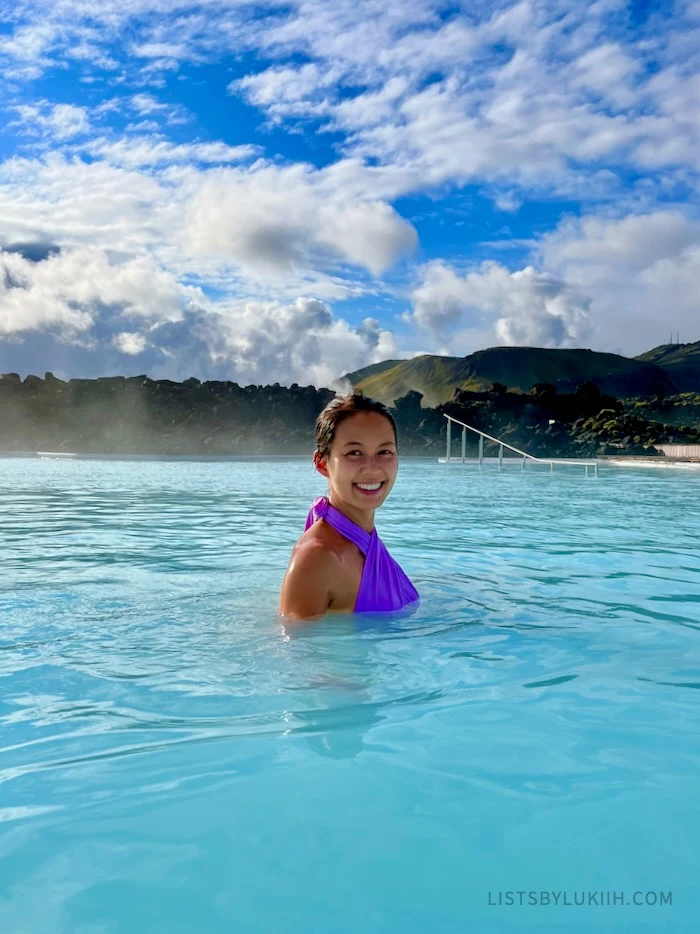
Blue Lagoon is a 20-minute drive from Keflavík International Airport, making it a great stop at the start or end of your trip. If you don’t have a rental yet, some Blue Lagoon tours will provide transportation.
💰 Admission Fee: Tiered experiences, starting at 12,990 ISK (about $94)
Blue Lagoon tickets have timed entry. Book an earlier time slot as they are cheaper, and it’s less crowded then. See more Blue Lagoon tips.
🚙 Parking Lot: Yes (large one)
🚽 Bathroom Facilities: Yes
🍀 Lukiih’s Take: Some people argue that the Blue Lagoon is touristy (which is true). But the unique milky-blue color and extraordinary surroundings make it feel like you’re on another planet, making it worth a visit.
Stop #2 (Option 1): Erupting Volcano
Before getting to Iceland, check for volcanic eruptions and activity for the unique opportunity to see an erupting volcano.
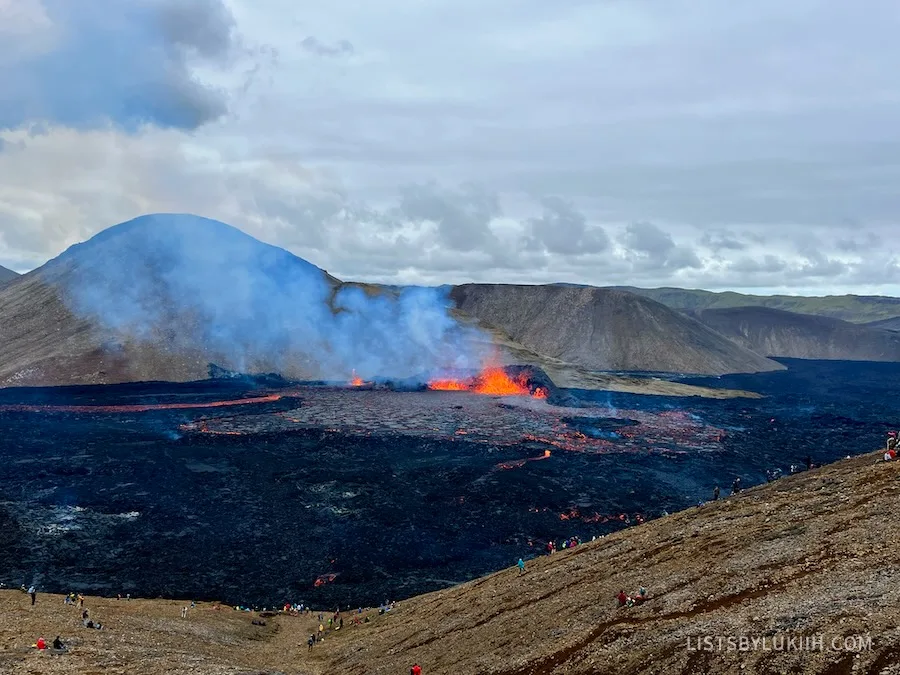
🍀 Lukiih’s Take: Fagradalsfjall erupted a week before my trip. I decided at the last minute to hike six miles to see it the moment I landed, and it became one of my trip’s highlights.
Stop #2 (Option 2): Reykjavík
If there are no erupting volcanoes to check out, head to the capital city of Reykjavík. It’s the largest city in Iceland and offers a city landscape in an otherwise nature-heavy country.
Park at the Harpan Concert Hall when visiting Reykjavík. It’s a spacious garage and costs around the same as street parking. You pay on your way out by entering your license plate number in the pay machine.
⭐️ Great Things To Do: Here are some great things to check out in Reykjavík:
- Braud & Co – They serve fantastic cinnamon buns, some of the best I’ve ever eaten!
- Hallgrímskirkja church – This is the tallest building in the capital and an architectural marvel.
- The Handknitting Association – This shop sells authentic lopapeysa, which are Icelandic sweaters.
Iceland is a low-crime country with very few tourist scams. However, there are tourist traps, such as shops selling counterfeit lopapeysa.
- Faxaflói Bay – Visit Faxaflói Bay for a chance to see whales.
The best whale watching in Iceland will be on the north side of the country, but Reykjavík is a good alternative if you’re not heading north.
- Local restaurants – Try Icelandic traditional food, including the infamous hákarl (fermented shark). I tried a piece, and it wasn’t as terrible as everyone makes it sound, but I wouldn’t eat it again.
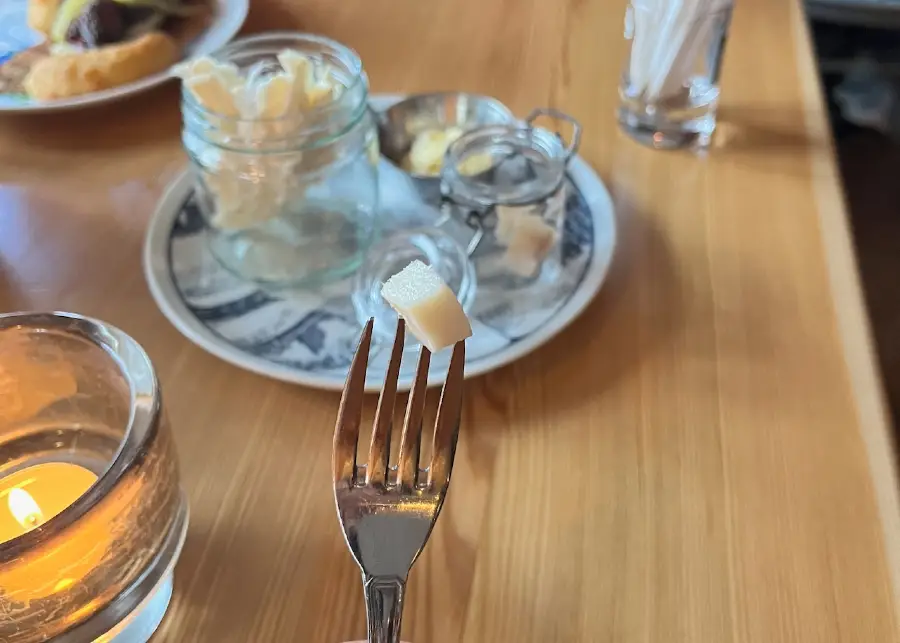
If you visit Iceland during the fall or winter months (October to April), you can typically see the northern lights. There are several places you can catch them, including Reykjavík.
🍀 Lukiih’s Take: Compared to everything else Iceland offers, Reykjavík pales in comparison, so I recommend spending half a day here or a day at most.
Where To Stay on Day 1: Selfoss
When settling down on the first day, pick a location within the Golden Circle area, as that’s where we’ll start on the second day. Selfoss, the largest town in the south, is a good place to stay.
🍀 Lukiih’s Take: I stayed at Selfoss campsite, which was clean, well-maintained, and comfortable. It had hot showers, a spacious kitchen with five tables, and an area where people left things they no longer needed (e.g., oil, salt, pasta).
Day 2: Golden Circle & Hrunalaug Hot Spring
On your second day in Iceland, explore the Golden Circle.
| Driving Information for Day 2 | |
|---|---|
| 📍 Driving Route Map | See Day 2 Route |
| 📏 Distance Covered | 138 miles |
| ⏰ Drive Time | 3 hrs 30 mins |
Stop #1: Kerid Crater
Kerid Crater is a beautiful crater that formed when the volcano collapsed on itself. It’s not considered one of the Golden Circle’s main attractions, so it’s usually less crowded.
You can walk around the rim in about 15 to 20 minutes and walk down near the lake.
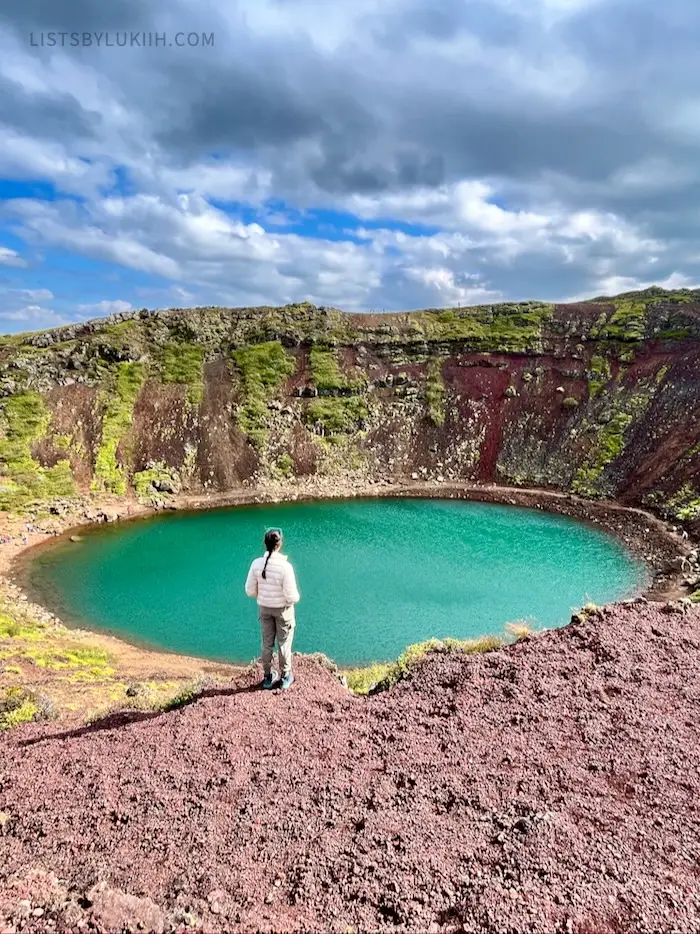
💰 Admission Fee: 500 ISK (about $4) per person
🚙 Parking Lot: Yes (medium-sized one)
🚽 Bathroom Facilities: Yes
🍀 Lukiih’s Take: If you’ve never seen a crater like this, I recommend stopping at Kerid Crater, as it’s quite beautiful and much larger than it looks in photos.
Stops #2: The Golden Circle
The famous Golden Circle is a 190-mile tourist route featuring three of Iceland’s most famous natural wonders not too far from the airport:
- Gullfoss – Translated to the “golden waterfall,” Gulfoss is one of Iceland’s most famous waterfalls.
- Geysir – The Geysir is a rare, steaming vent that erupts approximately every five minutes.
- Thingvellir National Park – A UNESCO World Heritage Site, Thingvellir National Park is notable for its volcanic landscape. It was also the site of the world’s first parliament and a key setting for Game of Thrones.
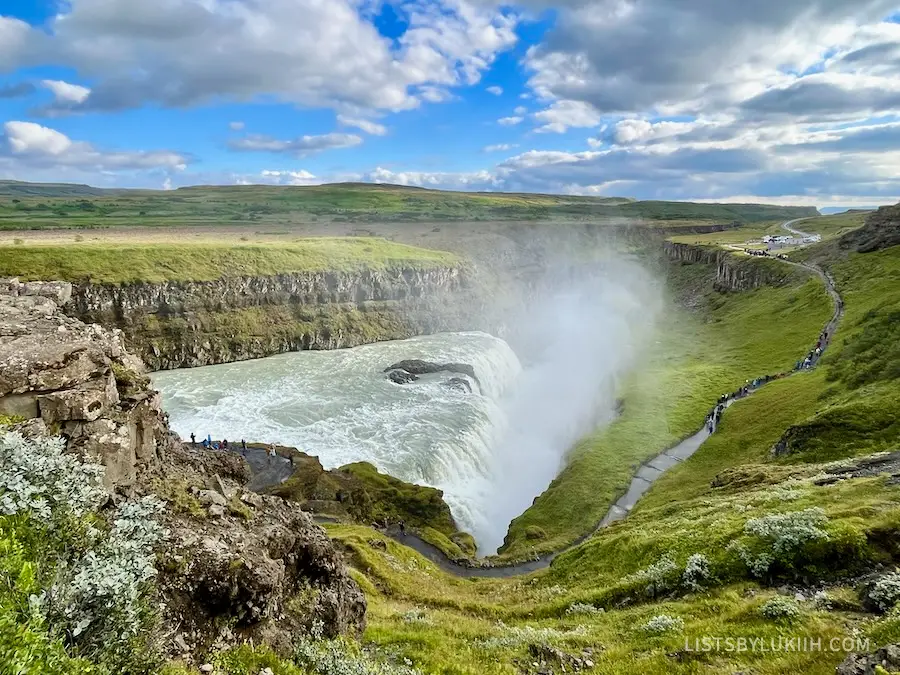
💰 Admission Fee: Free
🚙 Parking Lot: Yes (large one)
🚽 Bathrooms: Yes
🍀 Lukiih’s Take: Given the popularity and proximity of the Golden Circle, it’s worth a quick stop in each one. However, most of them were crowded in the summer. The Geysir was my favorite of the three; waiting for each eruption was exciting.
A popular activity near Thingvellir National Park is snorkeling in Silfra Fissure, which is located between two tectonic plates. My friends did it and said, “It was cold but worth it because it was so cool!”
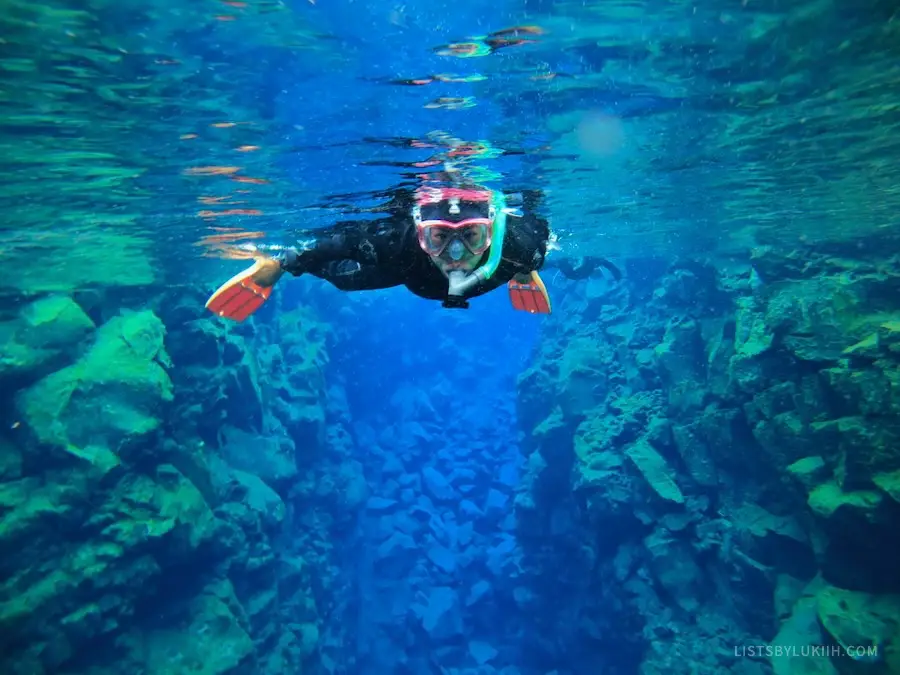
Stop #3: Hrunalaug Hot Spring
Hrunalaug Hot Spring is a small hot spring surrounded by beautiful nature. It’s located inside the Golden Circle area, making it a good stop after seeing the main attractions.
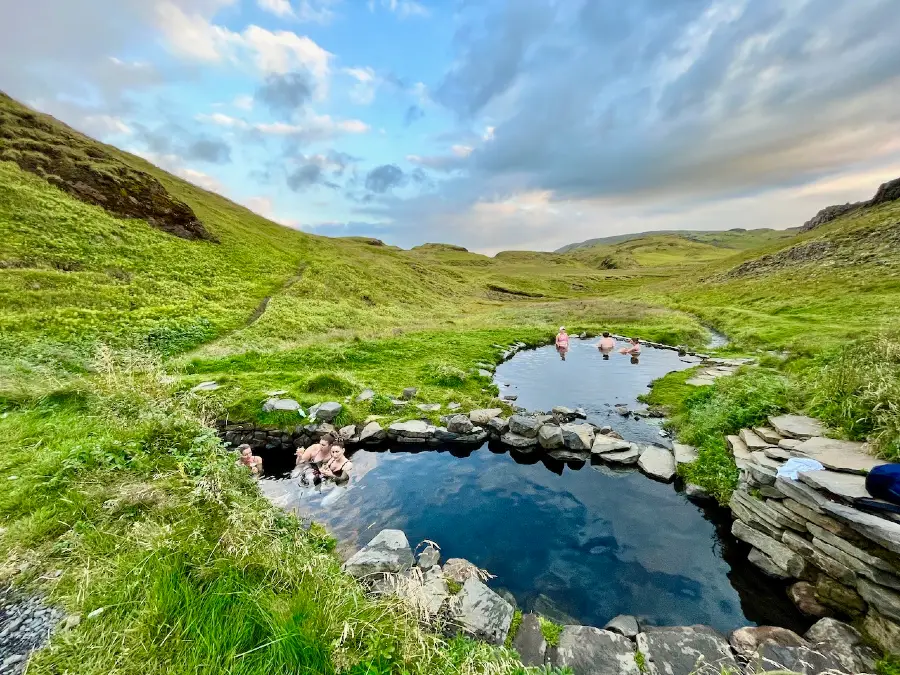
💰 Admission Fee: 2,000 ISK (about $14) per person
🚙 Parking Lot: Yes (small one)
🚽 Bathroom Facilities: None
🍀 Lukiih’s Take: Hrunalaug Hot Spring is easily crowded, but the surrounding valley is beautiful and worth a visit. If it’s too cold, you might want to skip it since it has no facilities.
See more tips on Hrunalaug Hot Spring.
Where To Stay on Day 2: Hella
When settling down on the second day, stay near the small town of Hella. That’s one of the few places the bus to Iceland’s Highlands leaves from on the third day.
🍀 Lukiih’s Take: I stayed at Gaddstadaflatir campsite in Hella. It was simple and well-maintained. It had a fairly small kitchen facility and a spacious campground but no showers.
Day 3: Landmannalaugar Epic Day Hike
On your third day in Iceland, prepare for an epic day trip in the Highlands.
| Driving Information for Day 3 | |
|---|---|
| 📍 Driving Route Map | See Day 3 Route |
| 📏 Distance Covered | 128 miles |
| ⏰ Drive Time | 4 hours by bus |
All-Day Stop: Landmannalaugar
The Highlands is an area in the middle of Iceland that’s largely uninhabited and composed of volcanic desert. It’s an extraordinary area, and Landmannalaugar is a stunning, unique, and accessible part of it.
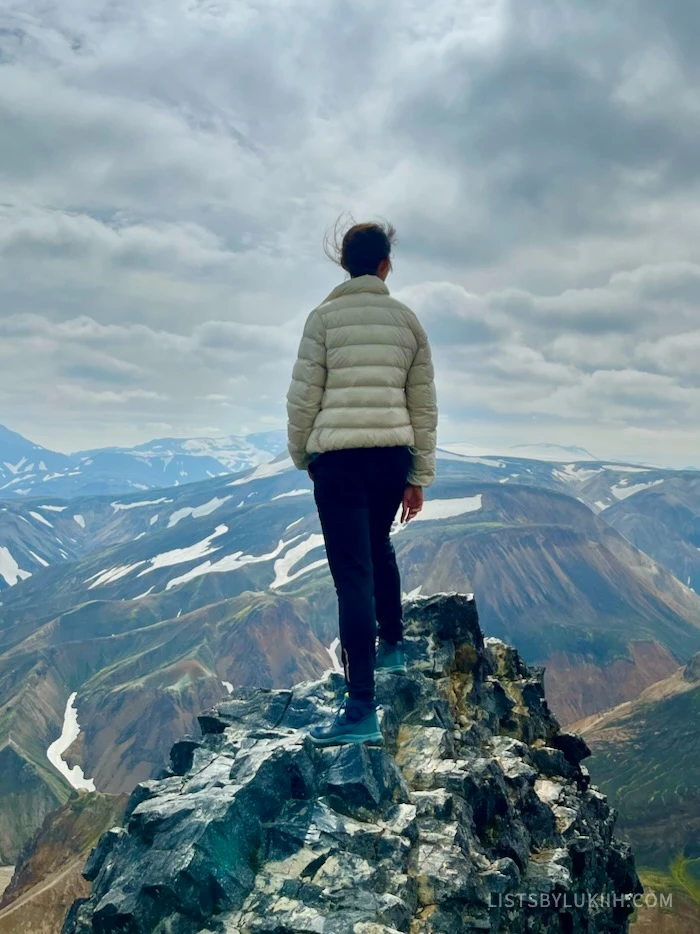
🥾 What To Hike at Landmannalaugar
Landmannalaugar has several trail options. For a hike you can do in a day, do the Brennisteinsalda-Blahnukur loop, a four- to six-hour loop. It’s steep at points but beautiful, with gorgeous views, constantly changing landscapes, and unique soil colors.
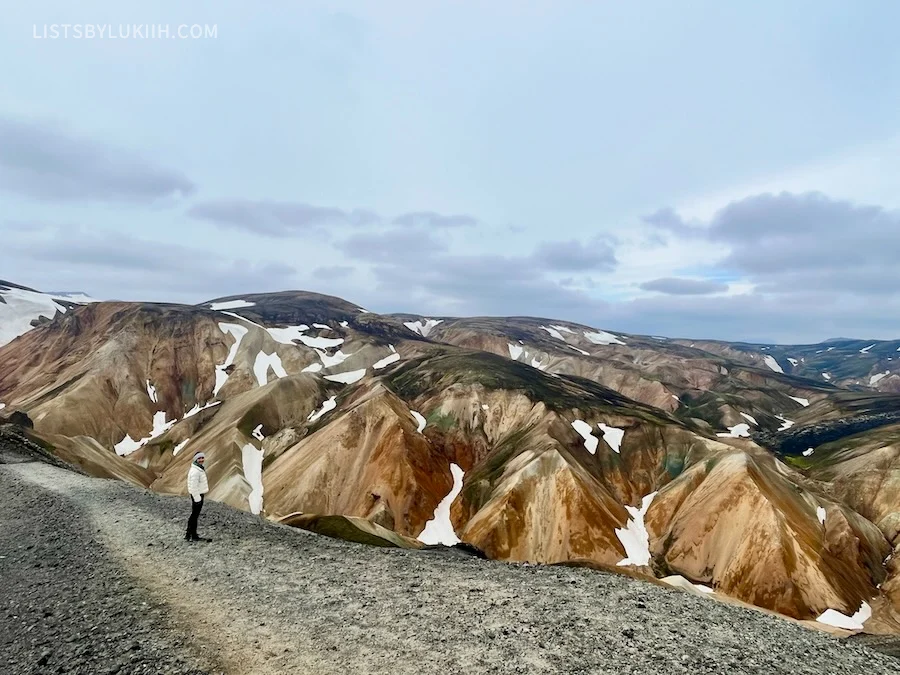
🚙 How To Get to Landmannalaugar
You are legally required to get a four-wheel drive (4WD) to visit the Highlands, which my campervan didn’t have.
Instead, I took the Hella bus to Landmannalaugar in the morning (from 9:10 am to 11:20 am) and took it back after the hike (from 4:30 pm to 6:30 pm). The bus is seasonal and doesn’t run year-round.
During peak season, the Hella bus to Landmannalaugar wasn’t full, so booking ahead doesn’t seem necessary. You lose cell service about halfway through the bus ride.
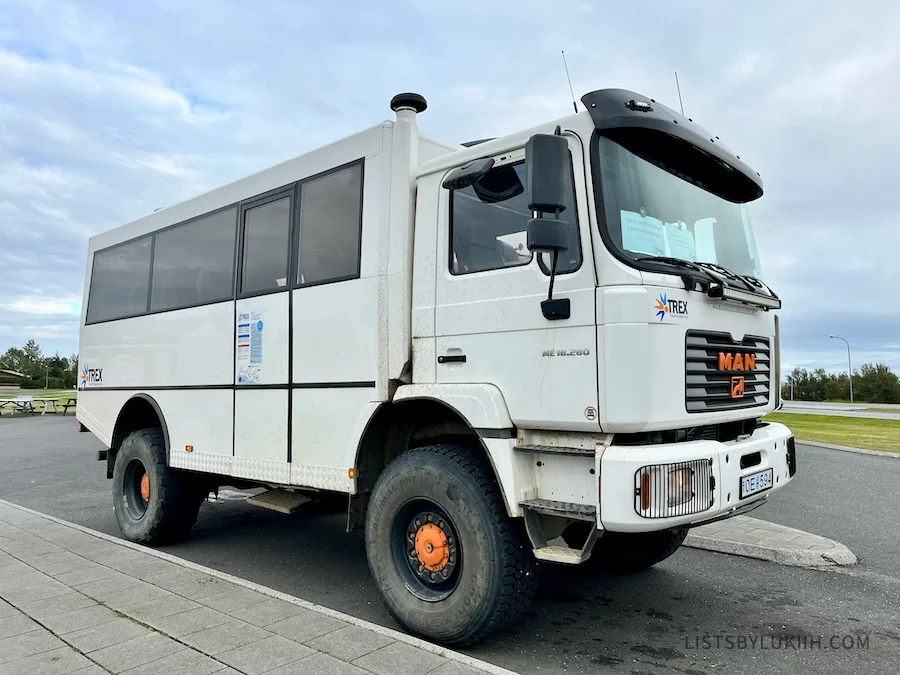
💰 Expected Cost: The round-trip bus ride was $115 during high season. The camp at Landmannalaugar has a bathroom facility that costs 500 ISK (about $4), a hot spring, and a few limited food options for sale.
🍀 Lukiih’s Take: Landmannalaugar is one of my all-time favorite hikes, with its interesting terrain and stunning views. It’s also a great way to see the Highlands if you’re not spending significant time there. It has inspired me to want to go back to Iceland just to visit the area.
Where To Stay on Day 3: Hella and Vík
You’ll want to stay somewhere in or between Hella and Vík on the third day.
🍀 Lukiih’s Take: I stayed at the same Gaddstadaflatir campsite because the bus returned to Hella, and I was too tired to drive after hiking.
Day 4: Waterfalls & Canyon
On your fourth day in Iceland, enjoy some beautiful waterfalls.
| Driving Information for Day 4 | |
|---|---|
| 📍 Driving Route Map | See Day 4 Route |
| 📏 Distance Covered | 157 miles |
| ⏰ Drive Time | 3 hrs 45 mins |
Stop #1: Seljalandsfoss and Gljufrabui
Seljalandsfoss and Gljufrabui are some of Iceland’s most popular waterfalls. The two are connected by a short ten-minute walking trail.
Seljalandsfoss is one of Iceland’s most unique waterfalls because you can walk around it; be warned that you will get very wet if you do so. People who came prepared wore full-body rain gear (meanwhile, I got drenched).
💰 Admission Fee: Free
🚙 Parking Lot: Yes (costs 700 ISK; about $5)
🚽 Bathroom Facilities: Yes
To avoid the crowded parking lot, you can park in Gljufrabui’s free lot and walk over, but I suggest still paying for parking at Seljalandsfoss to help maintain the paths.

Gljufrabui is a tall waterfall hidden inside a cave. During peak season, you’ll have to wait in line to enter the cave.
💰 Admission Fee: Free
🚙 Parking Lot: Yes
🚽 Bathroom Facilities: Yes
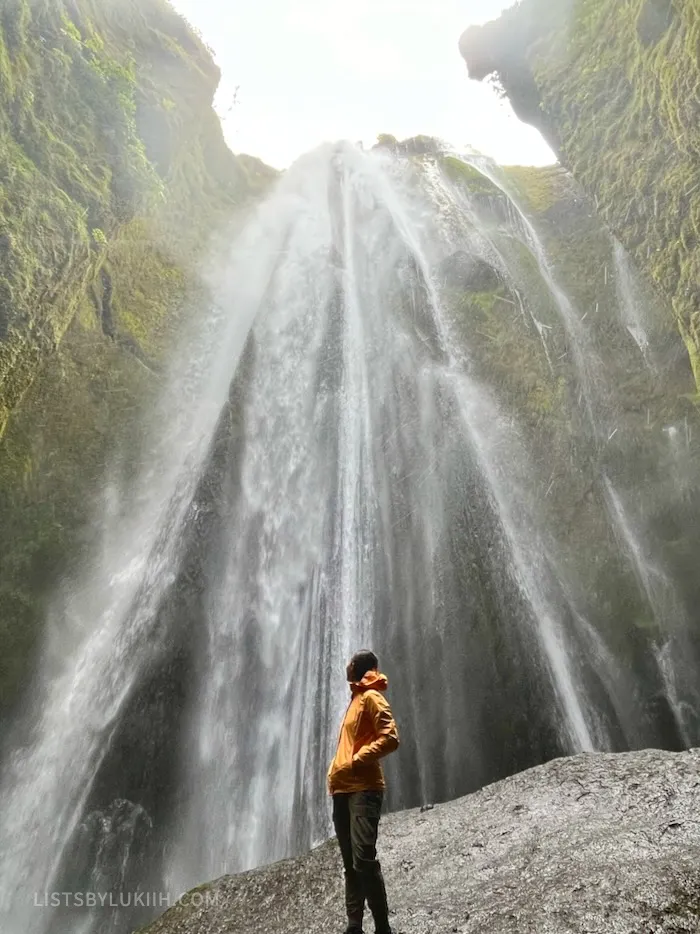
🍀 Lukiih’s Take: Seljalandsfoss is cool to walk around, especially if you’ve never visited such a waterfall. Gljufrabui was very crowded during the peak season, and I can’t say it was worth waiting in line for.
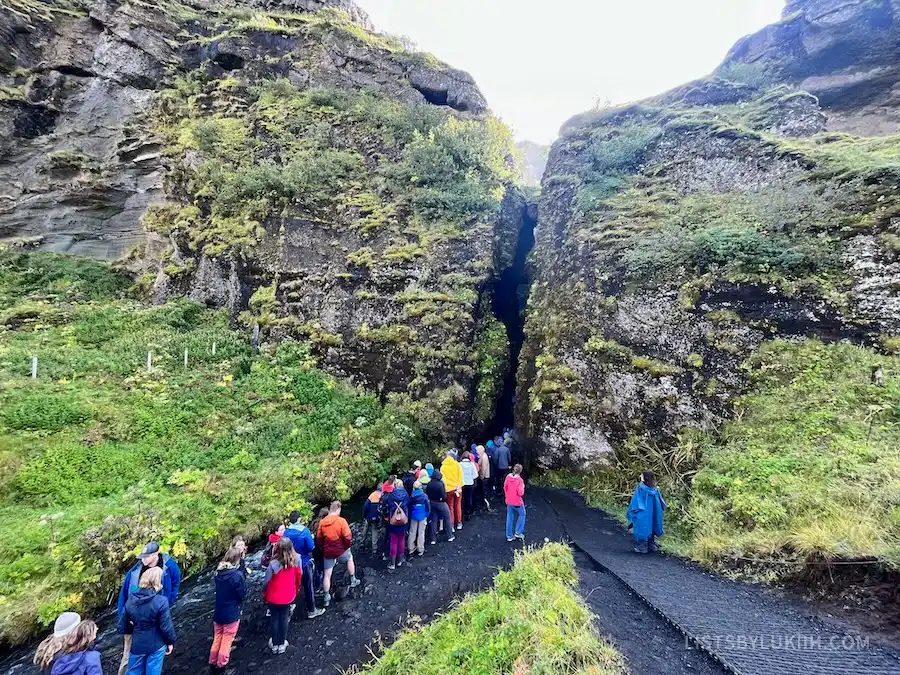
Stop #2: Skógafoss and Kvernufoss
Drive 30 minutes east to see another set of Iceladn’s best waterfalls.
Skógafoss is one of Iceland’s biggest waterfalls. Its water force is so strong that you’ll get wet if you walk close to it. Right next to it are the staircases leading to the Waterfall Way hike.
💰 Admission Fee: Free
🚙 Parking Lot: Yes (large one)
🚽 Bathroom Facilities: Yes (costs 200 ISK; about $1.50)
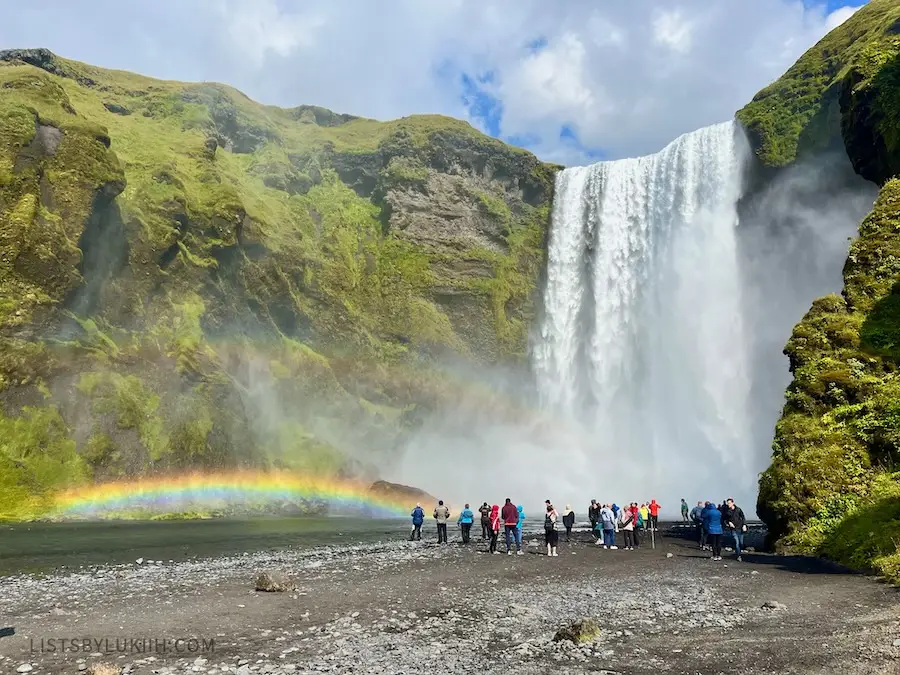
A very short drive away from Skógafoss is Kvernufoss, a less well-known idyllic and beautiful waterfall. You can access it after a short five-minute walk from its parking lot.
💰 Admission Fee: Free
🚙 Parking Lot: Yes (costs 750 ISK; about $5.50)
🚽 Bathroom Facilities: Yes (parking ticket gives you access to the nearby museum and its indoor bathrooms)
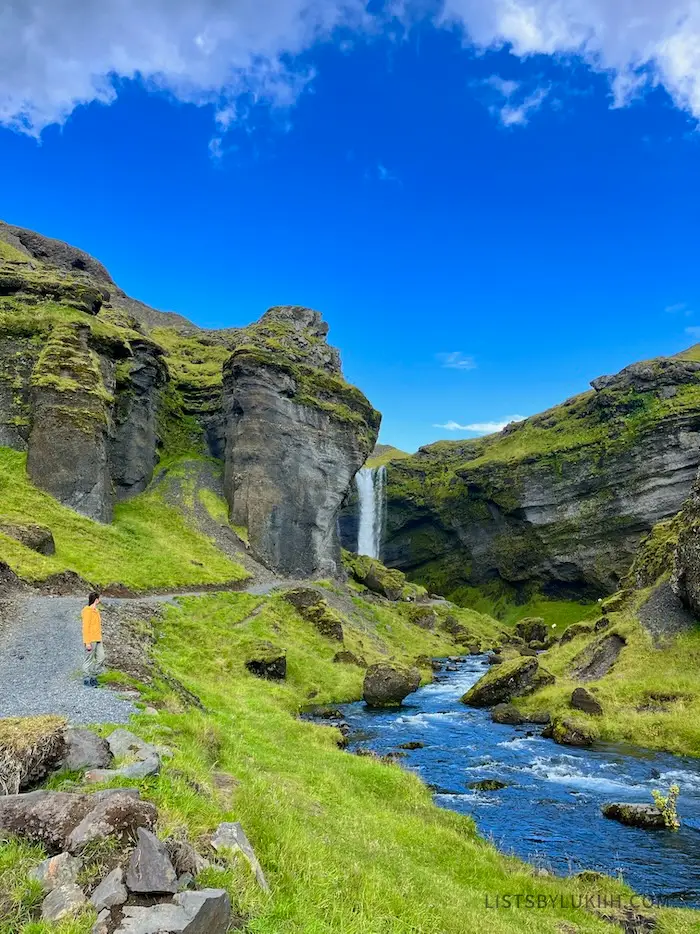
🍀 Lukiih’s Take: Skógafoss is very popular, and for a good reason: its massive power was awe-inspiring. However, the less well-known Kvernufoss was in beautiful, quiet surroundings, making it one of my favorite waterfalls in Iceland.
Stop #3: Icelandic Horse
Iceland is known for its wildlife and animals. Icelandic horses are unique in that they are shorter and have a special gait that riders say lends to a smoother ride.
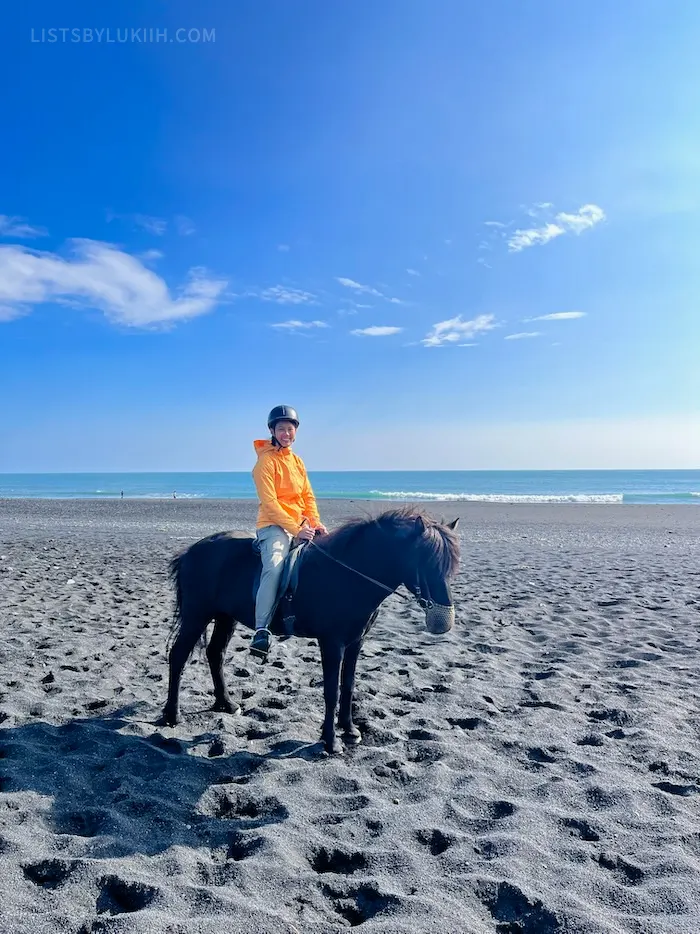
You can get close to an Icelandic horse by visiting a place that offers feeding or riding tours. I did an Icelandic horse riding tour in Vík, as it was highly rated, and the location was convenient.
💰 Expected Cost: The tour costs $100 per person.
🍀 Lukiih’s Take: I’ve done a few horse riding tours in different countries, and this one is good for beginners because it’s controlled and slow-paced.
Cell signal gets weak (turns to 3G) on the Ring Road between Vík and Vatnajökull glacier area. Download the Iceland map (via Google Maps offline feature) before you leave Vík.
While driving from Vík to Fjaðrárgljúfur Canyon, you’ll pass the lava fields called Eldhraun if you want to make a quick stop.
Stop #4: Fjaðrárgljúfur Canyon
Fjaðrárgljúfur Canyon is a unique, serpent-shaped canyon with three viewpoints.
The canyon became famous when Justin Bieber featured it in one of his music videos. Unfortunately, the rush of visitors destroyed the canyon’s surrounding grass, so some areas are roped off.
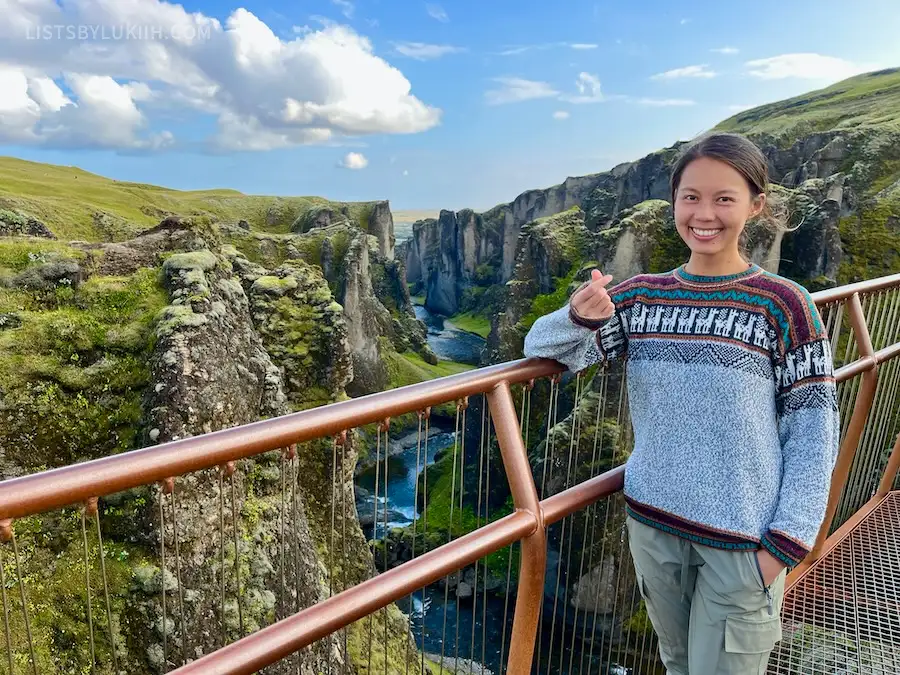
Fjaðrárgljúfur Canyon has two parking lots. I recommend parking at the higher for the best view.
💰 Admission Fee: Free
🚙 Parking Lot: Yes
🚽 Bathroom Facilities: Yes, at the lower parking lot
🍀 Lukiih’s Take: Like other attractions in Iceland, Fjaðrárgljúfur Canyon is stunning. The man-made viewpoints made it feel less natural than other sites, but the views are worth the visit.
Stop #5: Dverghamrar
If you want to break up your drive, you can stop for a brief visit at Dverghamrar, the dwarf cliffs with a legend behind it.
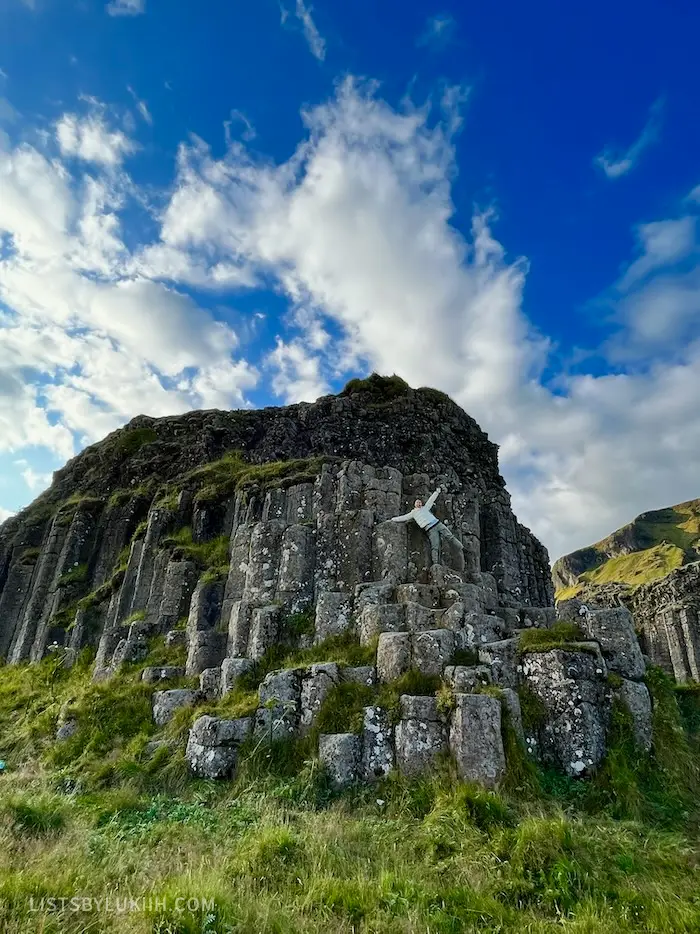
💰 Admission Fee: Free
🚙 Parking Lot: Yes (small one)
🚽 Bathroom Facilities: None
🍀 Lukiih’s Take: Dverghamrar is not a must-see. It’s usually empty so a quick stop is nice if you want to break up your drive like I did.
Where To Stay on Day 4: Skaftafell
When settling down on the fourth day, consider driving to and staying near Skaftafell nature reserve in Vatnajökull National Park, where you’ll have an early start on the fifth day.
🍀 Lukiih’s Take: I stayed at the nearby Svinafell campsite. It’s a beautiful, crowded campsite during high season (but not as crowded as the Skaftafell campsite). It has hot showers (two outdoor ones plus one in each bathroom) and a spacious kitchen facility that gets busy during peak meal times.
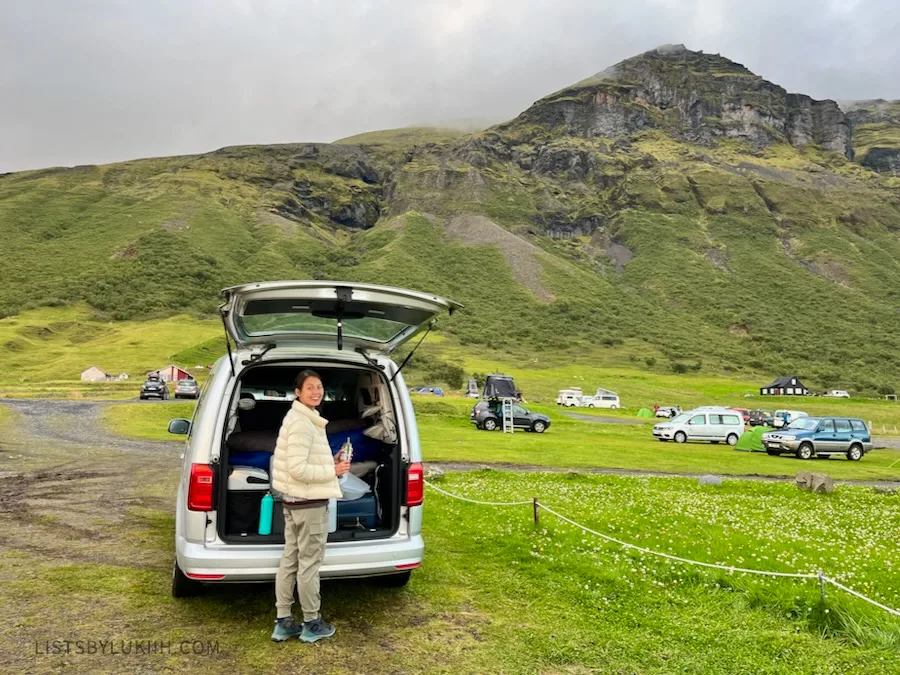
Day 5: Glacier Hike, Glacier Lagoons & Diamond Beach
On your fifth day in Iceland, start with a unique glacier hike.
| Driving Information for Day 5 | |
|---|---|
| 📍 Driving Route Map | See Day 5 Route |
| 📏 Distance Covered | 76 miles |
| ⏰ Drive Time | 2 hrs |
Stop #1 (Option 1): Vatnajökull Glacier Hike
Start your day with a glacier hike on Vatnajökull, Europe’s largest glacier. There are very few places in the world like Iceland where you can easily access a glacier.
Iceland’s glaciers are receding due to climate change, so they will become less accessible over time.
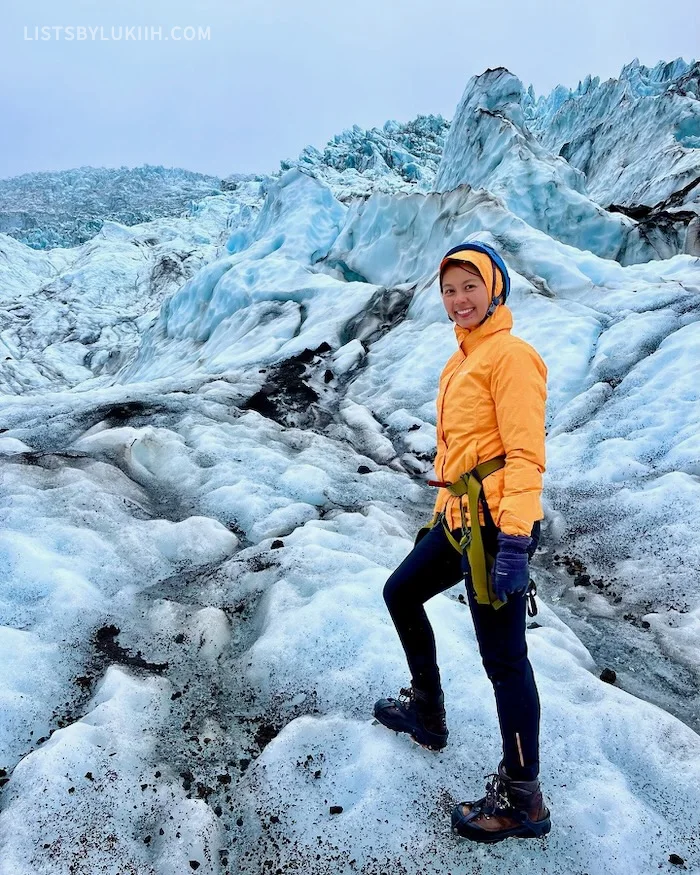
Learn more about hiking a glacier in Iceland.
Stop #1 (Option 2): Múlagljúfur Canyon
If you want to skip the expensive glacier hike, drive to Múlagljúfur Canyon, a beautiful and less well-known canyon.
A 40-minute hike in Múlagljúfur Canyon will take you to a gorgeous waterfall view. My friends described it as a “crazy place where you see a gold glacier first and then a lush green canyon next.”
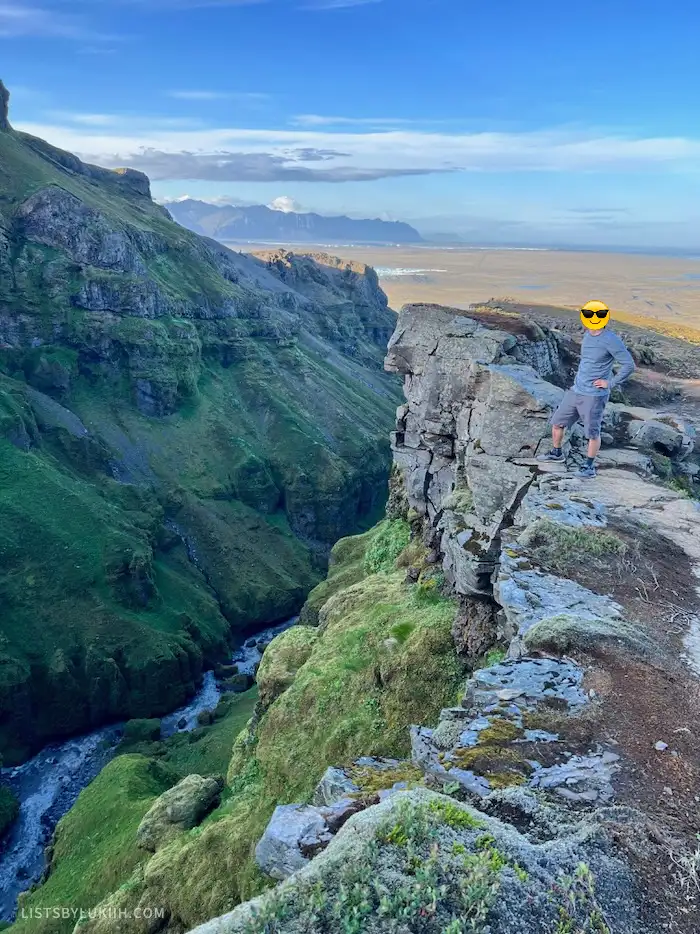
💰 Admission Fee: Free
🚙 Parking Lot: Yes (medium-sized one)
🚽 Bathroom Facilities: None
Stops #2: Jökulsárlón and Diamond Beach
Jökulsárlón Glacier Lagoon is a stunning must-see destination in Iceland. Some of the ice in the lagoon is over 1,000 years old.
Jökulsárlón Glacier Lagoon has several food stalls that close at 5 pm. You can also take a boat, kayak, or ice caves guided tour here.
💰 Admission Fee: Free
🚙 Parking Lot: Yes (large one)
🚽 Bathroom Facilities: Yes
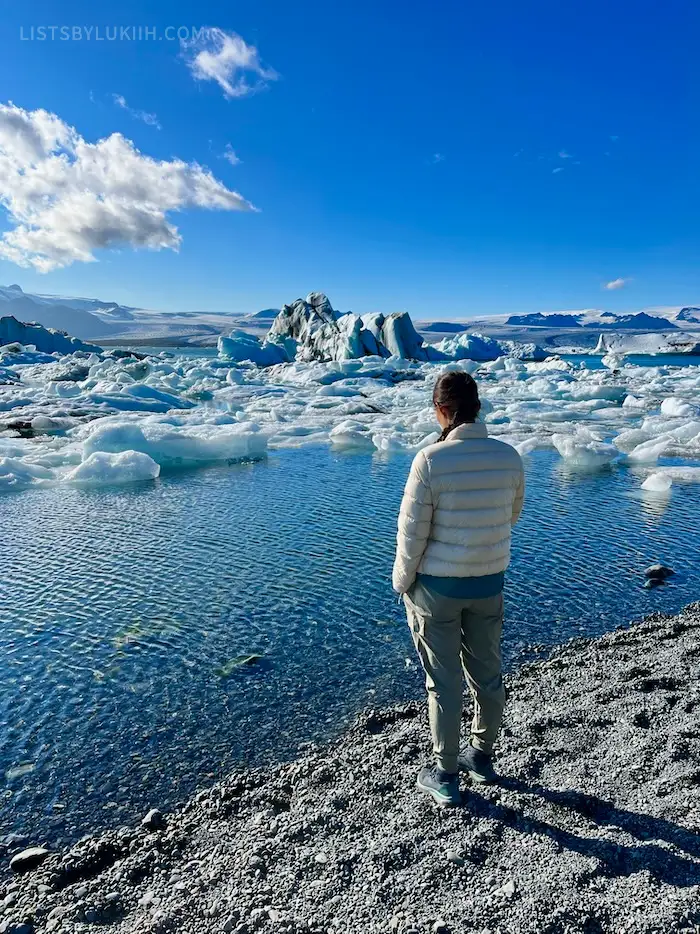
A short distance from the glacier lagoon is Diamond Beach, one of Iceland’s most famous black sand beaches with ice chunks floating in it. The ice comes from the Breiðamerkurjökull glacier slowly melting.
💰 Admission Fee: Free
🚙 Parking Lot: Yes (large one)
🚽 Bathroom Facilities: None
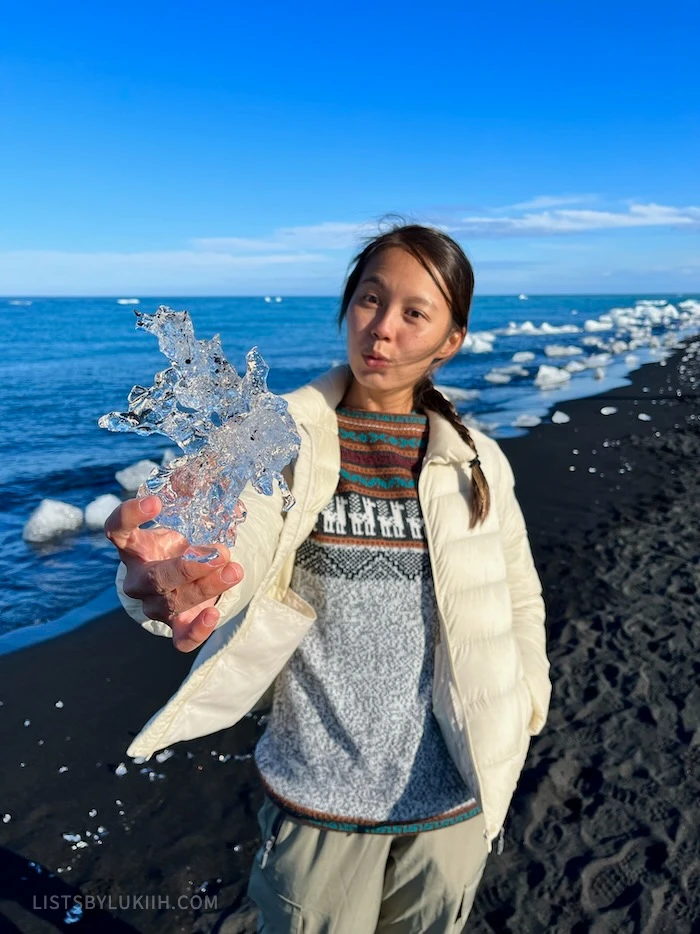
🍀 Lukiih’s Take: Jökulsárlón Glacier Lagoon looks unreal in real life and is one of my favorite stops despite the crowd. Diamond Beach is very unique, and I was surprised by how soft the black sand was.
Stop #4: Fjallsárlón Glacier Lagoon
If you want to see a more hidden glacier lagoon, you can make a quick stop at Fjallsárlón Glacier Lagoon.
💰 Admission Fee: Free
🚙 Parking Lot: Yes (small one)
🚽 Bathroom Facilities: None
🍀 Lukiih’s Take: Although this lagoon pales compared to Jökulsárlón, the backdrop of the glacier-capped mountains is breathtaking. It’s a short walk from the parking lot to reach the lagoon.
Where To Stay on Day 5: Skaftafell
On the fifth day, you can stay in the same location in Skaftafell since that’s where we’ll start the next day.
🍀 Lukiih’s Take: I stayed at the same Svinafell campsite as the previous day.
Day 6: Svartifoss, Black Sand Beach & Secret Lagoon
On the sixth day, prepare for a long drive west while stopping at top attractions.
| Driving Information for Day 6 | |
|---|---|
| 📍 Driving Route Map | See Day 6 Route |
| 📏 Distance Covered | 244 miles |
| ⏰ Drive Time | 5 hrs 30 mins |
Stop #1: Svartifoss Hike
Svartifoss is a unique waterfall falling from basalt columns formed by lava cooling and contracting. You have to go on a 30- to 60-minute paved uphill hike to reach it.
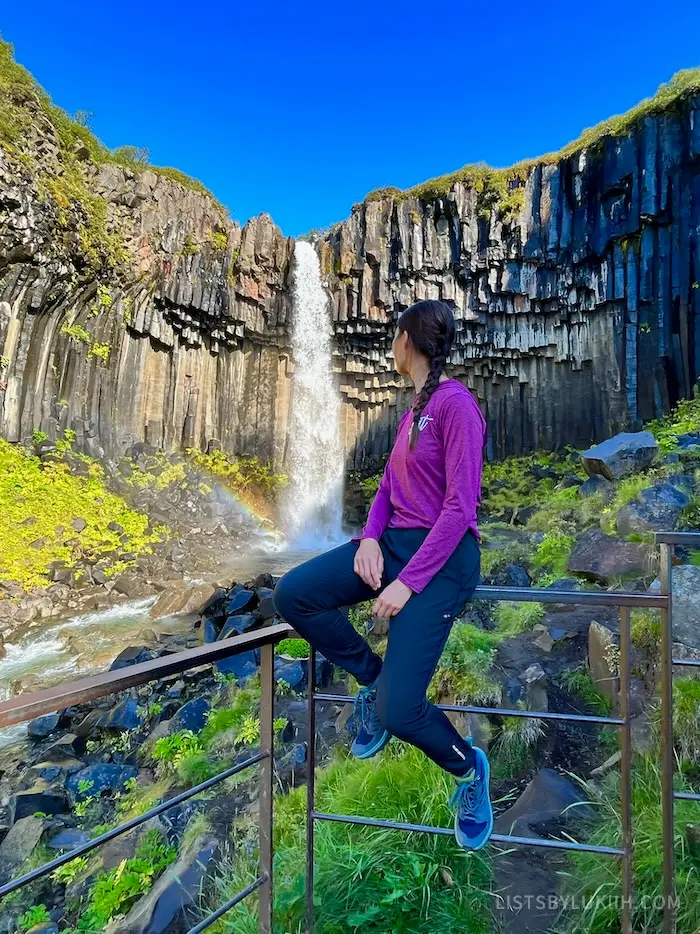
The trailhead is not clearly marked, so just look for a start with an uphill climb not far from the Skaftafell’s visitor center.
💰 Admission Fee: Free
🚙 Parking Lot: Yes (pay at the Skaftafell’s visitor center)
🚽 Bathroom Facilities: Yes, at the visitor center
🍀 Lukiih’s Take: Svartifoss was a rewarding short hike. The viewing platform is small, so I recommend getting there earlier to beat the crowds. I started the hike at 9:30 am during peak season and had the hike mostly to myself.
Stop #2: Dyrhólaey Arch
After Svartifoss, head back west to the popular Dyrhólaey Arch near the town of Vík. It’s one of the best places on the South Coast to see puffins. About half of the world’s puffin population lives in Iceland.

From the parking lot, you can walk further down to the cliffs to see the puffins. The best time to catch them is early morning or evening, but I saw plenty in the early afternoon.
💰 Admission Fee: Free
🚙 Parking Lot: Yes (large one)
🚽 Bathroom Facilities: Yes
🍀 Lukiih’s Take: Seeing puffins in real life is very cool (I didn’t even know they could fly; I thought they were more like penguins). The arch didn’t impress me, but visiting the puffins was worth it.
Stop #3: Reynisfjara Black Sand Beach
The sea stacks at Reynisfjara Black Sand Beach are one of Iceland’s most iconic and photographed spots. They are an incredible view, though the color of the sea stacks can vary depending on the weather.
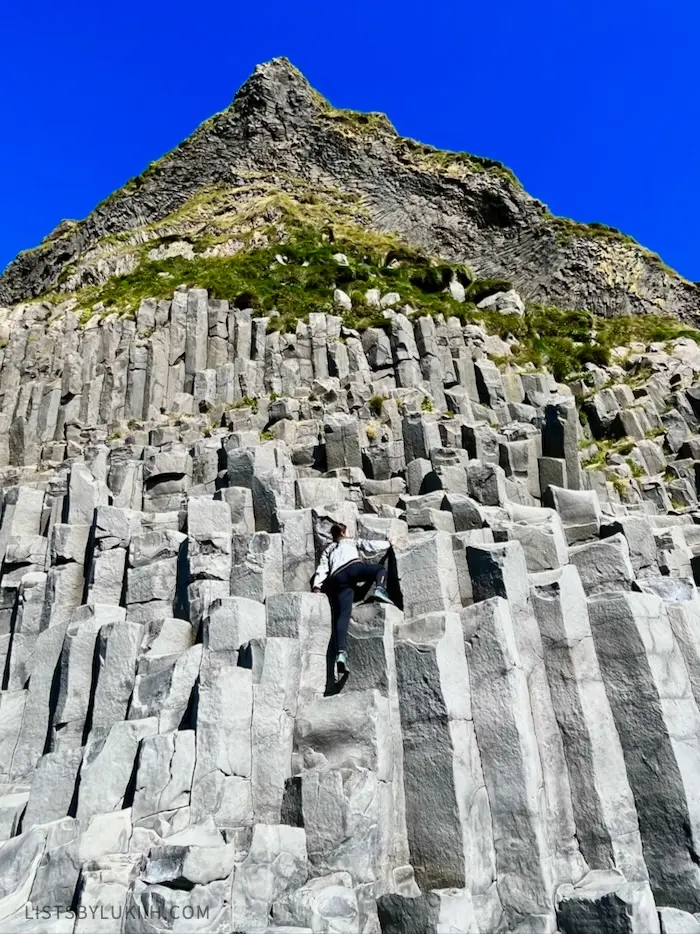
💰 Admission Fee: Free
🚙 Parking Lot: Yes (large one)
🚽 Bathroom Facilities: Yes, in the cafe
🍀 Lukiih’s Take: The sea stacks are iconic, so it’s worth seeing them in person. The landscape isn’t particularly stunning compared to everything else in Iceland, but I enjoyed climbing them.
Stop #4: Waterfall Way Hike
Head back to Skógasfoss to hike part of the Waterfall Way hike, an easy ten-mile hike where you pass by over 25 waterfalls.
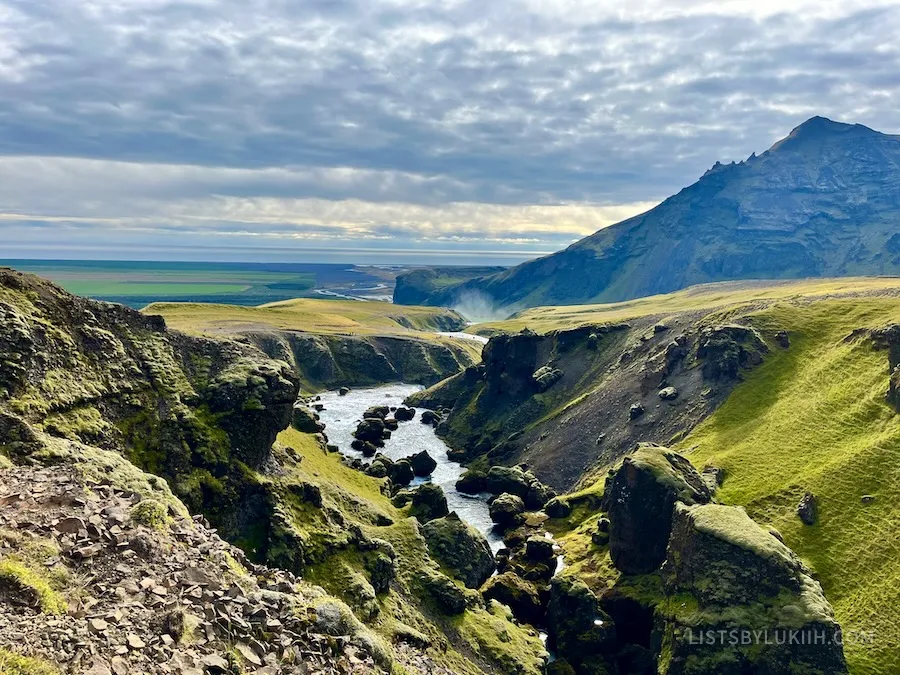
The Waterfall Way hike is located up the staircases next to Skógafoss and is not very well-known. I barely saw anyone 45 minutes into the hike.
💰 Admission Fee: Free
🚙 Parking Lot: Yes (large one)
🚽 Bathroom Facilities: Yes (costs 200 ISK; about $1.50)
🍀 Lukiih’s Take: The hike itself is not that interesting, so I recommend this hike if you love waterfalls and can’t get enough of them. It will take several hours, but it’s an out-and-back, so you can turn around anytime. I only hiked for 90 minutes to have enough time to make it to the next stop before they closed.
Stop #5: Secret Lagoon
Secret Lagoon is the oldest swimming pool in Iceland (made in 1891), and it’s a great value hot spring. Most visitors agree that Secret Lagoon feels hotter than Blue Lagoon.
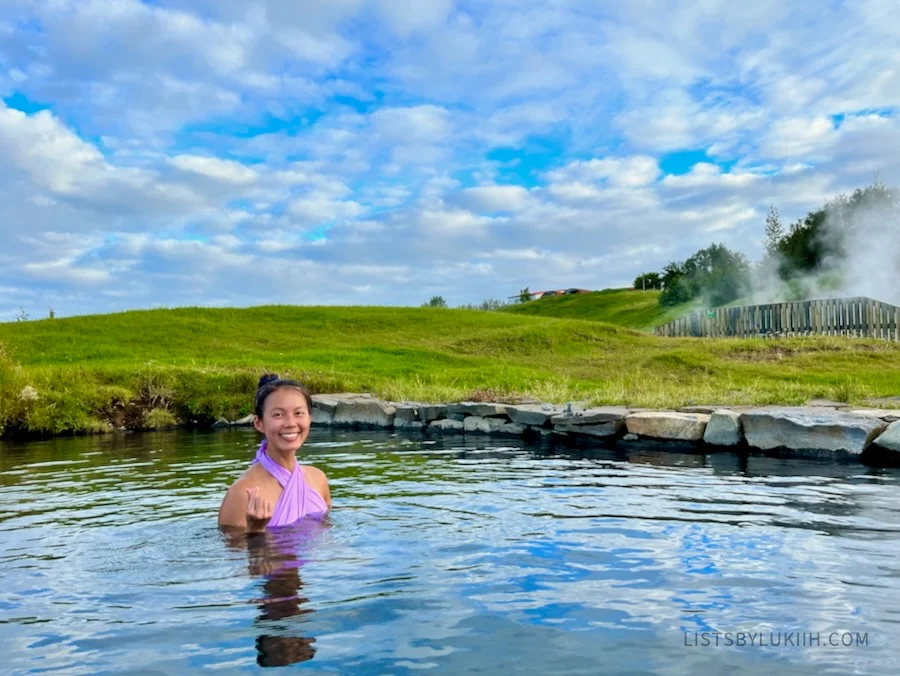
Secret Lagoon has a communal shower, and you’re required to shower nude before getting into the pool.
💰 Admission Fee: 3,300 ISK (about $24)
🚙 Parking Lot: Yes (large one)
🚽 Bathroom Facilities: Yes
See more tips on Secret Lagoon.
Where To Stay on Day 6: Thingvellir
When settling down on the sixth day, consider staying in the Golden Circle area near Thingvellir for an early start on the last day.
🍀 Lukiih’s Take: I stayed at Thingvellir Campsite, a small, isolated campsite next to a beautiful lake. It doesn’t have hot running water or a kitchen facility, but it does have bathrooms.
The campsite is only for tent campers and not campervans (but I didn’t realize this when I stayed there). Instead, you can stay by nearby Thingvellir – Nyrðri Leirar.
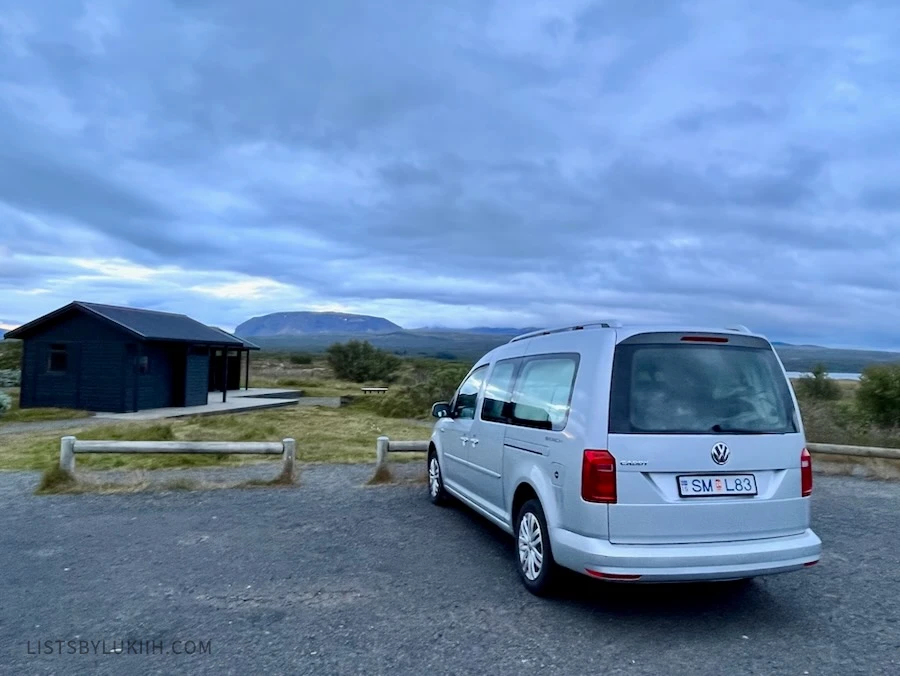
Day 7: Glymur Waterfall Hike & Reykjavík
End your Iceland trip on the last day with another great hike.
| Driving Information for Day 7 | |
|---|---|
| 📍 Driving Route Map | See Day 7 Route |
| 📏 Distance Covered | 119 miles |
| ⏰ Drive Time | 3 hrs |
Stop #1: Glymur Waterfall Hike
The Glymur Waterfall hike is an interesting, moderate four-mile hike involving a log crossing, a cave pass, some steep moments, and different waterfall viewpoints.
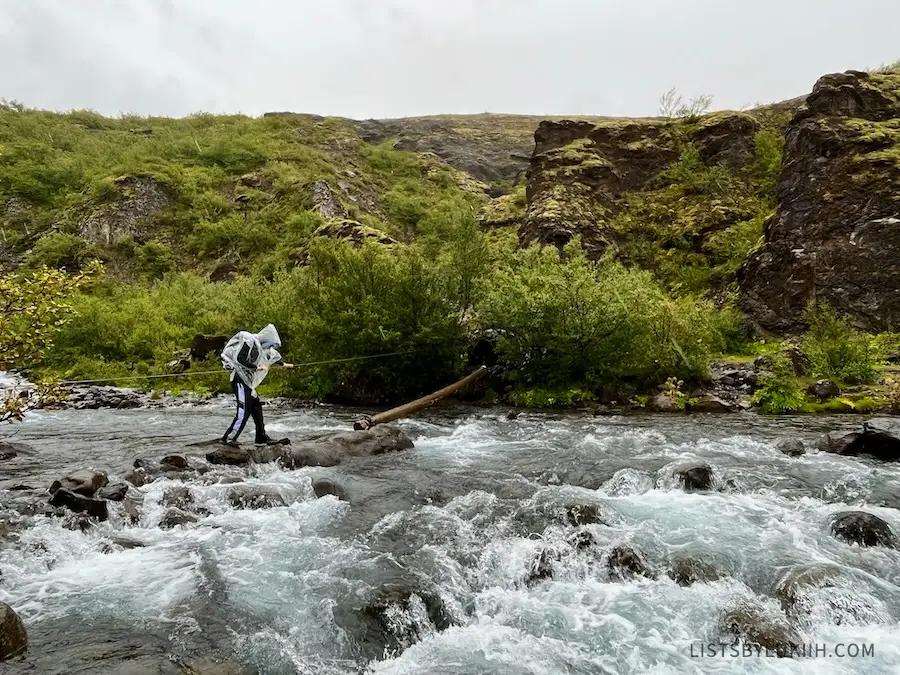
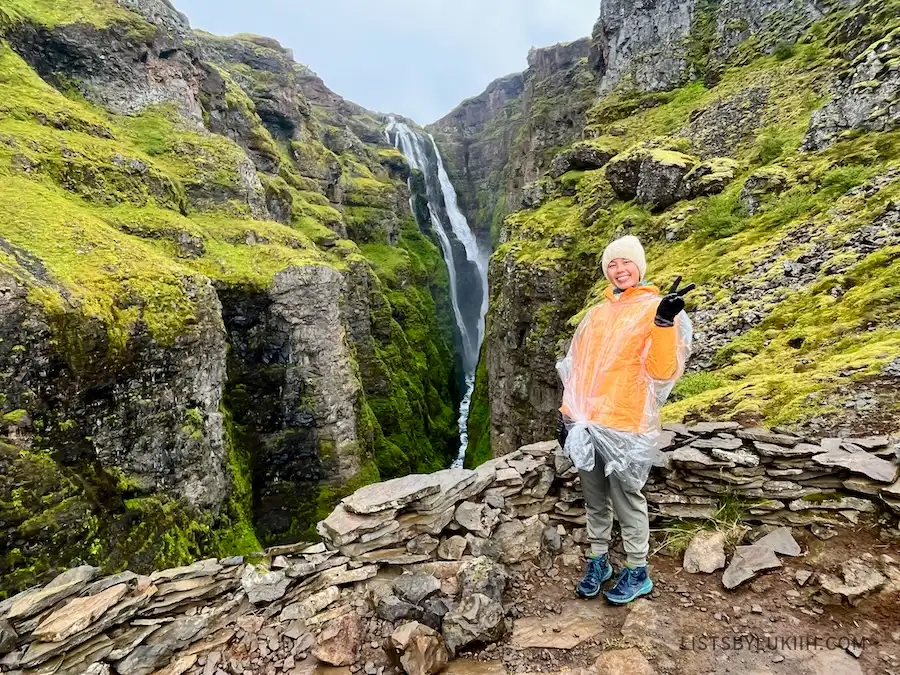
💰 Admission Fee: Free
🚙 Parking Lot: Yes (medium-sized one)
🚽 Bathroom Facilities: None
🍀 Lukiih’s Take: Glymur Waterfall is a great moderate hike because of its unique terrain (e.g., the log crossing, the cave pass). This hike is more about the journey than the destination; the waterfall will not be the most impressive one you see in Iceland.
Stop #2: Reykjavík
If you didn’t get to visit Reykjavík at the beginning of your trip, it’s a great place to settle down at the end of your trip.
Where To Stay on Day 7: Grindavik Campsite
On your last day in Iceland, stay within an hour or two of driving time from the Keflavík International Airport (KEF) so you can easily fly out the next day.
🍀 Lukiih’s Take: I stayed at Grindavik campsite, a very modern campsite. It was overcrowded when I visited because the nearby volcano, Fagradalsfjall, was erupting.
How much will a trip set you back? I share my travel expenses in this Iceland budget breakdown.
With More Time: Snaefellsnes Peninsula
If you’re spending eight or nine days in Iceland, you can add Snaefellsnes Peninsula on the western coast at the beginning or end of your trip.
Snaefellsnes Peninsula is a small peninsula with some top attractions:
- Kirkjufell – One of Iceland’s most unique-looking mountains, Kirkjufell has an iconic arrowhead shape and is located next to Kirkjufellsfoss, a waterfall often photographed with it.
- Stykkishólmur – The peninsula’s biggest town, Stykkishólmur is a fishing village with a modern-looking church and a small red lighthouse.
- Arnarstapi – Arnarstapi is a small fishing village with stunning sea cliffs.
- Búðir – A small settlement in a lava field near the ocean, Búðir features an interesting black building against an otherwise largely empty landscape.
🍀 Lukiih’s Take: I would prioritize the Snaefellsnes Peninsula only if I had eight days or more in Iceland. While it has some great stops, it’s relatively far from the South Coast and has fewer impressive sites.
Iceland Trip Planner 2025
Make planning easier with my flexible, research-backed travel planner—shaped by real experience. It has:
- Up-to-date travel info
- A well-curated itinerary
- Practical, firsthand insights & tips
- A simple budget tracker
- A starter packing list
- Fully customizable sections
Built in Notion, this is the tool I personally use to plan every trip. I genuinely love it and creating a Notion account is free.
Lists by Lukiih is a small site I fund myself. Downloading my trip planner is the best way to support me and keep it running—thanks!
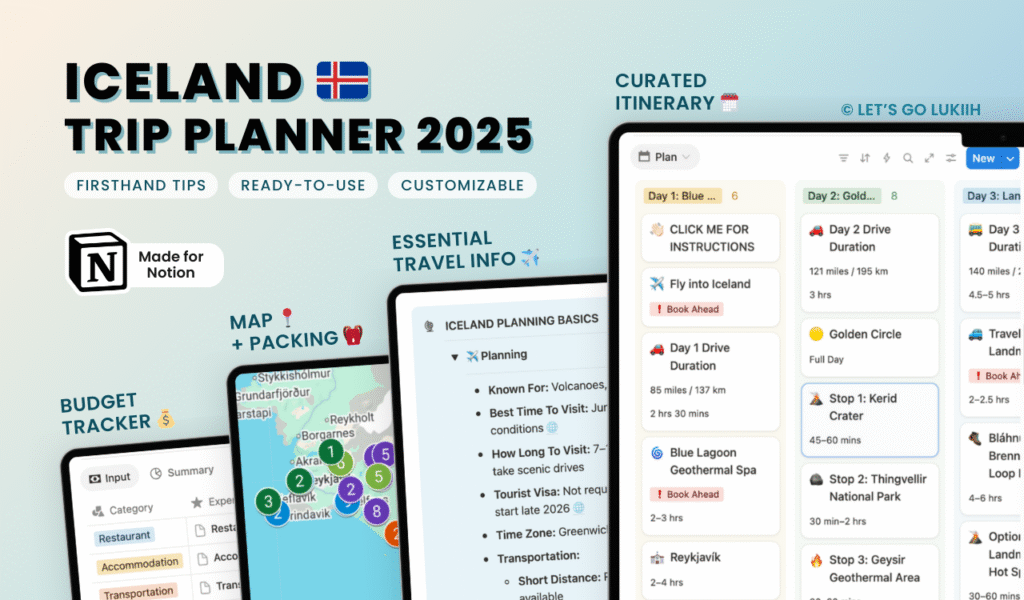
Iceland Travel Guides
- 🇮🇸 Planning a Trip to Iceland: 11 Practical Things To Know
- 🚙 Iceland South Coast: Efficient 7-Day Road Trip Itinerary
- 🚐 My Iceland Campervan Trip: How To Plan One + Tips
- 💰 My Iceland Trip Cost: My Budget Breakdown (2025)
- 🧊 Hiking a Glacier in Iceland: My Honest Review & Tips
- ♨️ Hrunalaug Hot Spring: My Honest Review & Tips
- ☀️ Visiting Iceland in August: Tips & What To Know
